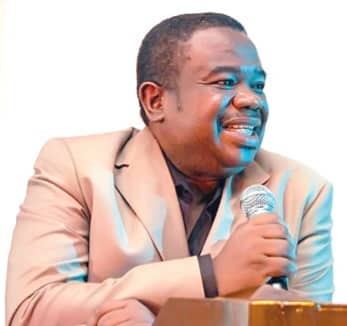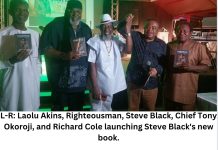The vibrant activities and good profit in the Nigerian recording industry in the first half of the 1970s resulted in substantial local and foreign investments in the second half of the 70s and early 80s.
Before these new investments, professional recording facilities were limited to the three studios in Lagos. The first was the EMI 8 track studio on Wharf Road Apapa set up with EMI technology, a smaller version of the set up at the EMI Abbey Road Studio in North London where the Beatles recorded their big hits. The engineering team was led by Emma Odenusi. The second was the Philips 2 track studio situated at Ijora Causeway in Ijora which was driven by Philips machines and headed by Inyang Henshaw who was a successful Highlife artiste in his own right. The third was the Decca 8 track studio at Lawani Street in Abule Oja, Yaba set up with 3M technology. The lead engineer, Emma Akpabio, had a team that included L.A.K. Adeniran, John Malife and Martin Ikebuaku.
Manufacturing of black vinyl records took place primarily at the Phillips factory at Ojota and that of Record Manufacturers Nigeria Ltd (RMNL), at the same premises as the EMI Studio in Apapa. People came from all over West Africa to make use of these facilities.
Because of the heightened activities in the industry, there were several rapid developments. Phillips which had been acquired by Phonogram, bought from Ibadan based businessman, Bayo Akinnola, the 16 track ARC studio on Alhaja Kofoworla Street in Ikeja. The studio was originally set up by world renowned drummer, Ginger Baker during his tour of Nigeria. The engineering team was led by Demola Odebiyi assisted by Raymond Njoku. The company now known as Phonogram expanded and moved its manufacturing facilities from Ojota to Satellite Town in Lagos. The manufacturing facility was later taken over by the foreign owned NIRA Sounds which also turned it into a CD plant.
Apala music maestro, Haruna Ishola set up the 24-track Phonodisk studio with MCI technology and a manufacturing facility at Ijebu Igbo and a major rehearsal facility on Ikorodu Road in Lagos.
One of the foremost indigenous players in the industry, Chief G.A.D. Tabansi set up a 24-track Tabansi Studio and a manufacturing facility in Onitsha and another manufacturing facility on Oregun Road in Ikeja.
Rogers All Stars, fresh from its huge success with Ikenga Superstars and Prince Nico Mbarga, set up a top class 24-track studio in Awka Anambra State with engineering talent like John Malife, formerly of Decca, manning the console.
Shanu Olu Trading Company, the frontline distributor for Decca West Africa, also set up its own 24-track studio and manufacturing plant in Ijebu Ode.
Record Manufacturers of Nigeria Ltd (RMNL) expanded its operations and moved its facilities from Apapa to a more modern and spacious location in Ogba near Ikeja.
Simeon Anochie of Anodisc Records, began arrangements to set up state of the art recording and manufacturing facilities at Ogbor Hill in Aba.
The Afrodisia Studio in Abule Oja took delivery of a brand-new Neve console and 24-track Studer recorder to replace its 3M equipment. This new set of equipment was some of the most expensive in the world.
EMI moved from Apapa to Ikeja and set up two studios at its new location on Oregun Road. Studio ‘A’ was a fully automated 24 track facility driven by MCI technology. Studio ‘B’ had the cherished EMI 8 track console which had hosted many great recordings including Fela’s Shakara and Paul McCartney’s “Band on the Run”. The new EMI studios which had an engineering team led by Monday Oki also had Bayo Aro.
Olumo Records boldly gave birth to Recordisc in the Iju area of Lagos with another 24-track studio based on Neve technology and a record manufacturing plant. The engineering team at the studio was led by Raymond Njoku who used to work with Demola Odebiyi at Arc Studio.
CBS Records which previously had its repertoire distributed in Nigeria by EMI, set up offices at Allen Avenue in Ikeja headed by Keji Okunowo who had previously managed A&R and Public Relations operations at Phonogram. The offices eventually moved to Aromire Avenue and later to Adeniyi Jones Avenue, all in Ikeja.
Apart from the above investments, there were countless smaller investments in the industry with many millions sunk in with the cumulative potentials to provide thousands of jobs.
As proof of the wisdom in the several millions of Naira invested in the industry, a new string of hit records with substantially improved audio quality, followed. Haruna Ishola’s Phonodisk Studio opened the floodgates with the sleek recording of the young and very charismatic law student of the University of Nigeria, Nsukka, Kris Okotie. The album, “I Need Someone” was produced by Odion Iruoje. The Odion Iruoje magic obviously was still at work. Odion had left EMI and made a successful recording at Decca with Cameroonian superstar, Manu Debango called “Home Made”. The success of Kris Okotie’s “I Need Someone” was a defining moment for the industry. Odion once again had in session his old partners from BLO, but this time the ‘O’ was a massively creative keyboard player, Lemmy ‘Otu’ Jackson.
Another development was the arrival of a deluge of Cameroonian instrumentalists that flooded Nigeria, apparently to exploit the fruits of the vibrant investments in the industry. While Kris Okotie released ‘Just for You’, another successful album at Phonodisk, the attempt by Phonodisk to achieve the same success with Gbubemi Amas, whose album, “Grill” was massively promoted, was unrewarded.
With the opening of the EMI Oregun Road studios in 1981, activities shifted from Phonodisk to EMI. In a great example of half-truth advertising, the EMI studio was advertised as a 32-track facility. While in theory the 24 track MCI recorder could be linked to another 8-track recorder in the studio resulting in 32-track operation, the studio was basically a 24-track set up running on 2 inch tapes.. Say what you might, the advertising worked and all roads led to EMI. The opening of the studio also marked the second coming of Odion Iruoje to EMI. At 23 years old, this author who had previously done some production work with Odion Iruoje at Decca, on the recommendation of Iruoje,.was engaged at EMI as part of the production and A&R team,
Odion came back to EMI with the undisputed hottest act of the time, Kris Okotie and quickly set about recording a new album. Simultaneously, Sonny Okosun was in the studio, not as a performer, but as a producer of a brand new female singer that people had seen on TV before, reading the news. Her name – Onyeka Onwenu! The author was also in the studio at the same time, both as producer and performer, on another album project. Onyeka Onwenu’s “Endless Life”, Tony Okoroji’s “Juliana” and Kris Okotie’s “Show Me Your Backside” were released almost simultaneously and all went into the charts. Shortly after, Sonny Okosun’s “Mother & Child”, Dizzy K. Falola’s “Excuse Me Baby” among other recordings done at the Oregun studio were released and EMI was riding high!
Down the street on Oregun Road was the Lagos Headquarters of Tabansi Records which appeared to have caught the bug from EMI. Tabansi’s response to the noise from EMI was profound. First, was the release of “Kill Me With Love” by Jide Obi who was incidentally a colleague of Kris Okotie at the University of Nigeria. The second was Bunny Mack’s “My Sweety, My Sugar”. The third was the release of “Lover Boy” by Felix Lebarty who had played guitar on the successful recordings of both Kris Okotie and Dizzy K. Falola. The public response to “Ngozi”, a song from Felx Lebarty’s album “Lover Boy” was phenomenal. A lot of activities were also going on at other recording companies and labels throughout the country.
Watch out as the tale of ‘the Unwritten Book of the Nigerian Recording Industry and the Talents that Propelled it’ continues.
















